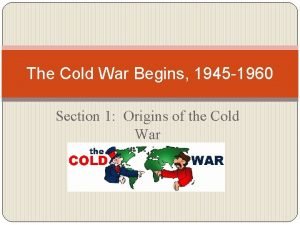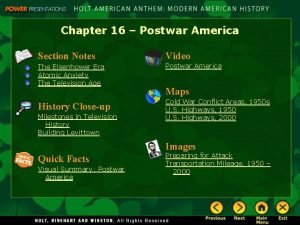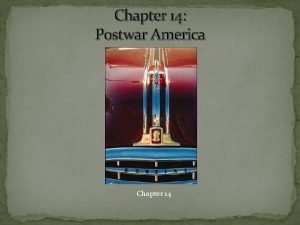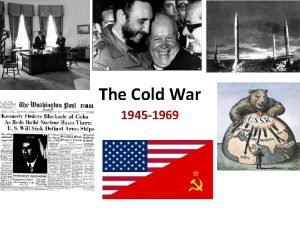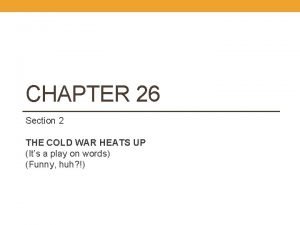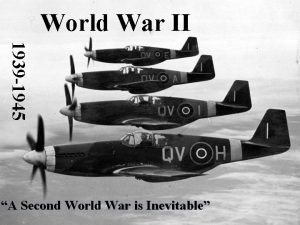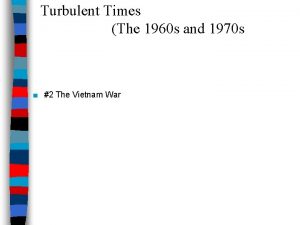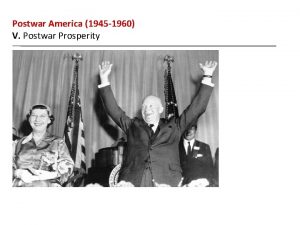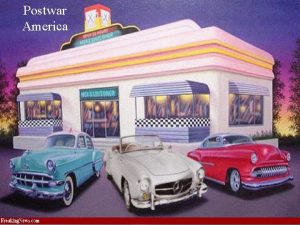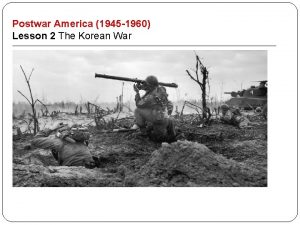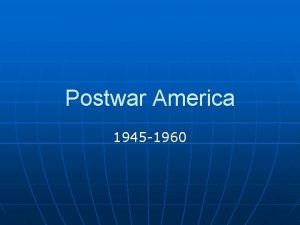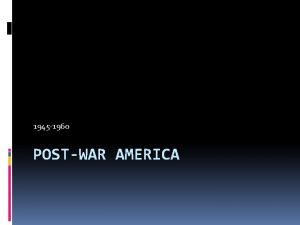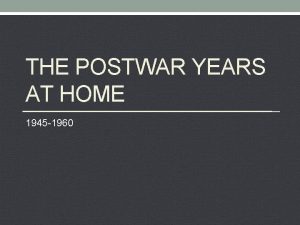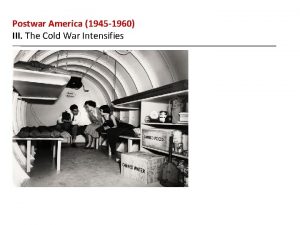Postwar America 1945 1960 II The Korean War










- Slides: 10

Postwar America (1945 -1960) II. The Korean War

Postwar America (1945 -1960) II. The Korean War Learning Objectives • • • Explain how Mao Zedong and the communists gained power in China. Describe the causes and the reasons for U. S. involvement in the Korean War. Identify the long-term effects and outcomes of the Korean War.

Postwar America (1945 -1960) II. The Korean War A. China Turns Communist 1. Jiang Jieshi and Mao Zedong resumed their civil war after Japan’s defeat in 1945. Since Mao had the support of the massive peasant class, Mao won the civil war in 1949. Jiang fled to Taiwan and Mao ruled the People’s Republic of China. 2. Americans were shocked at this event and some blamed Truman for not supporting Jiang more. The truth is that Jiang was a corrupt, terrible leader and we had no business backing him up. Secretary of State Dean Acheson convinced Americans that there was nothing we could have done.

B. US Involvement in Korea 1. Korea was divided at the 38 th parallel, North Korea supported by the USSR and South Korea supported by America. In June of 1950, North Korea invaded South Korea. America and South Korean forces were driven back to Pusan, at the extreme southern end of the peninsula. 2. The UN voted to assist South Korea. The Soviets could have stopped the vote but they weren’t present. Under Mac. Arthur, UN forces held fast at Pusan and landed behind enemy lines at Inchon, cutting the enemy off from supplies. By late 1950, North Korea had been routed. 3. Mac. Arthur next invaded North Korea. He assured Truman that China would not intervene and pursued the enemy to the Yalu River. China invaded and Mac. Arthur retreated to the 38 th parallel. Truman, an advocate for limited war, fired Mac. Arthur for insubordination, specifically because he wanted to nuke China.

C. Outcomes of the Korean War 1. UN forces regrouped at the 38 th parallel, the original border. Eisenhower was elected President in 1952 and promised to end the war. He quietly threatened nukes and after Stalin’s death, the communists agreed to a cease-fire, still in effect today. 2. No one won the war, Korea remains divided today. However, it established a dangerous precedent that a President could use troops even if Congress doesn’t declare war. It also led to increased military spending. 3. The US decided to create an Asian alliance, similar to NATO. SEATO (Southeast Asia Treaty Organization) was a defensive alliance designed to halt the spread of communism in the region.

China Turns Communist Jiang Jieshi, shown with his U. S. -educated wife Soong May-ling, led a nationalist Chinese government that attracted Western support.

U. S. Involvement in Korea Analyze Maps This map shows the Korean peninsula as war began. Which countries border North Korea?

U. S. Involvement in Korea A U. S. soldier aims a missile while his fellow soldiers take cover during a Korean War battle. For President Truman, supporting South Korea in the Korean War was about stopping the spread of communism.

Outcomes of the Korean War Analyze Data After the Korean War how much more did the U. S spend on defense than before the war?

Outcomes of the Korean War Ongoing military exercises between U. S. and South Korean forces, such as these on the Namhan River, emphasize the U. S. commitment to the safety and security of the South Korean people.
